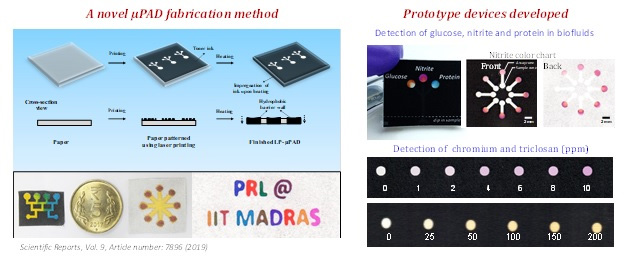 Scientists have developed a paper-based sensor that can detect antimicrobials or antibiotics that have an inhibitory effect on bacteria in water bodies by a see and tell mechanism.
Scientists have developed a paper-based sensor that can detect antimicrobials or antibiotics that have an inhibitory effect on bacteria in water bodies by a see and tell mechanism.
As the world is tackling the effects of one pandemic, the scientific community has warned that Antimicrobial Resistance (AMR) could be the next big pandemic, and this would involve a battle with several pathogens.
Water bodies are the major source for the dissemination and transfer of AMR. Periodic monitoring of antimicrobials and antibiotic-resistant genes is the key to assess the current situation of AMR in India. In these conditions, low cost and field-deployable sensors to detect antimicrobials in water bodies could be a viable tool for environmental surveillance.
The novel strategy for low-cost fabrication of the robust Laser Printed- Microfluidics Paper-Based Analytical Sensors developed by IIT Madras will help detecting antimicrobials easily in the parts per million range. It will also help understand the relationship between AMR and AMR triggering pollutants and assist policymakers in framing solutions to tackle grand societal AMR challenge.
 Department of Science and Technology (DST), Government of India- Water Technology Initiative in bilateral collaboration with UK’s Natural Environment Research Council (NERC) and Engineering and Physical Sciences Research Council (EPSRC) under Indo UK Water Quality Research Programme, has supported IIT Madras to develop the sensors. The novel strategy of combining adsorption based pre-concentration using reagents that undergo a measurable color change enabled parts per billion level detection of antimicrobials. The process utilizes the easily available laser printer and hence offers tremendous potential for large scale sensor fabrication. It could enable community-driven microfluidics and facilitate mass surveillance.
Department of Science and Technology (DST), Government of India- Water Technology Initiative in bilateral collaboration with UK’s Natural Environment Research Council (NERC) and Engineering and Physical Sciences Research Council (EPSRC) under Indo UK Water Quality Research Programme, has supported IIT Madras to develop the sensors. The novel strategy of combining adsorption based pre-concentration using reagents that undergo a measurable color change enabled parts per billion level detection of antimicrobials. The process utilizes the easily available laser printer and hence offers tremendous potential for large scale sensor fabrication. It could enable community-driven microfluidics and facilitate mass surveillance.






























